
Initial Results from Ongoing paltusotine Carcinoid Syndrome Open Label Phase 2 Study A Randomized, Parallel Group Study to Evaluate the Safety, Pharmacokinetics, and Dose Response of Paltusotine Treatment in Subjects with Carcinoid Syndrome Exhibit 99.2
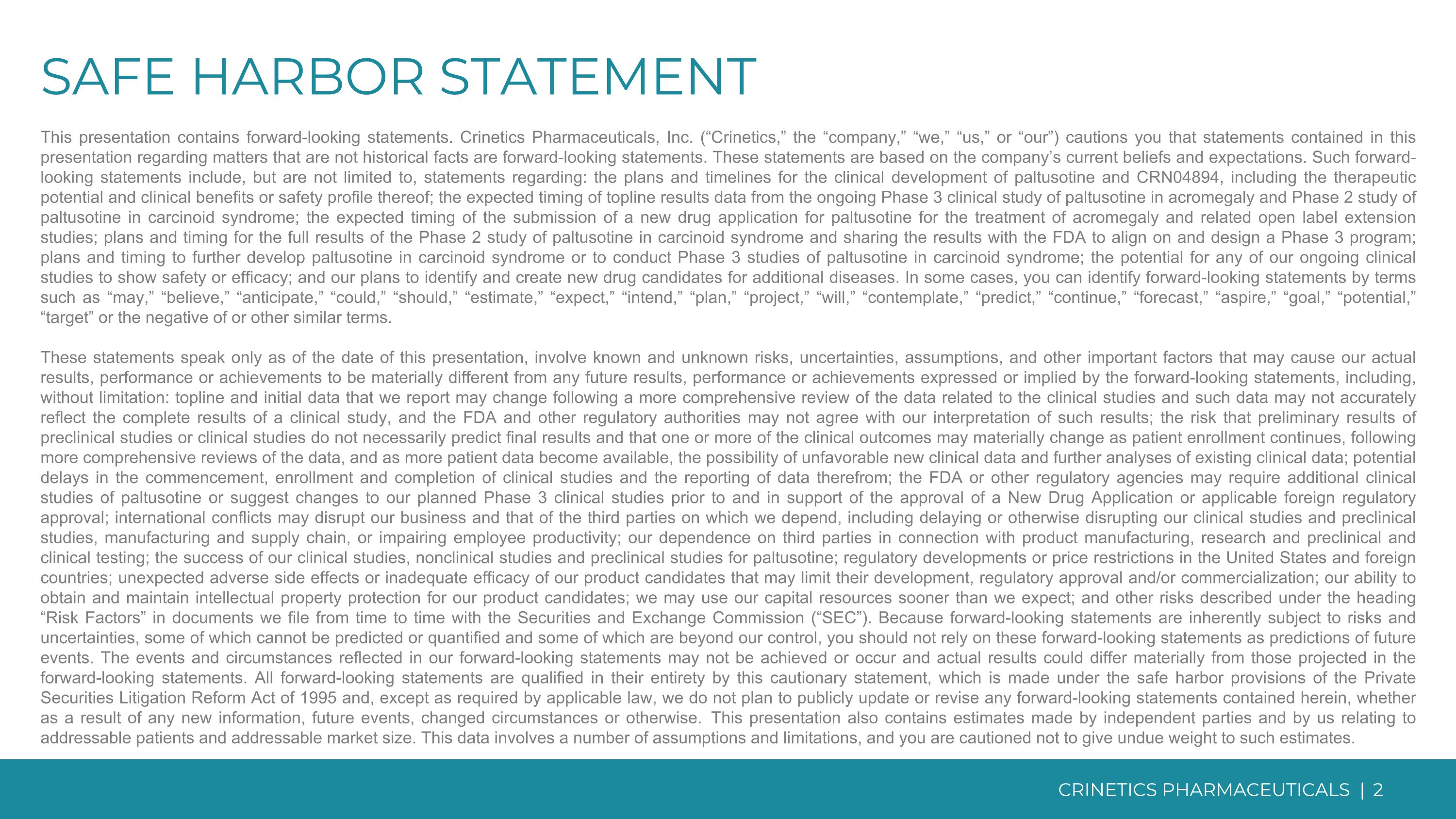
SAFE HARBOR STATEMENT This presentation contains forward-looking statements. Crinetics Pharmaceuticals, Inc. (“Crinetics,” the “company,” “we,” “us,” or “our”) cautions you that statements contained in this presentation regarding matters that are not historical facts are forward-looking statements. These statements are based on the company’s current beliefs and expectations. Such forward-looking statements include, but are not limited to, statements regarding: the plans and timelines for the clinical development of paltusotine and CRN04894, including the therapeutic potential and clinical benefits or safety profile thereof; the expected timing of topline results data from the ongoing Phase 3 clinical study of paltusotine in acromegaly and Phase 2 study of paltusotine in carcinoid syndrome; the expected timing of the submission of a new drug application for paltusotine for the treatment of acromegaly and related open label extension studies; plans and timing for the full results of the Phase 2 study of paltusotine in carcinoid syndrome and sharing the results with the FDA to align on and design a Phase 3 program; plans and timing to further develop paltusotine in carcinoid syndrome or to conduct Phase 3 studies of paltusotine in carcinoid syndrome; the potential for any of our ongoing clinical studies to show safety or efficacy; and our plans to identify and create new drug candidates for additional diseases. In some cases, you can identify forward-looking statements by terms such as “may,” “believe,” “anticipate,” “could,” “should,” “estimate,” “expect,” “intend,” “plan,” “project,” “will,” “contemplate,” “predict,” “continue,” “forecast,” “aspire,” “goal,” “potential,” “target” or the negative of or other similar terms. These statements speak only as of the date of this presentation, involve known and unknown risks, uncertainties, assumptions, and other important factors that may cause our actual results, performance or achievements to be materially different from any future results, performance or achievements expressed or implied by the forward-looking statements, including, without limitation: topline and initial data that we report may change following a more comprehensive review of the data related to the clinical studies and such data may not accurately reflect the complete results of a clinical study, and the FDA and other regulatory authorities may not agree with our interpretation of such results; the risk that preliminary results of preclinical studies or clinical studies do not necessarily predict final results and that one or more of the clinical outcomes may materially change as patient enrollment continues, following more comprehensive reviews of the data, and as more patient data become available, the possibility of unfavorable new clinical data and further analyses of existing clinical data; potential delays in the commencement, enrollment and completion of clinical studies and the reporting of data therefrom; the FDA or other regulatory agencies may require additional clinical studies of paltusotine or suggest changes to our planned Phase 3 clinical studies prior to and in support of the approval of a New Drug Application or applicable foreign regulatory approval; international conflicts may disrupt our business and that of the third parties on which we depend, including delaying or otherwise disrupting our clinical studies and preclinical studies, manufacturing and supply chain, or impairing employee productivity; our dependence on third parties in connection with product manufacturing, research and preclinical and clinical testing; the success of our clinical studies, nonclinical studies and preclinical studies for paltusotine; regulatory developments or price restrictions in the United States and foreign countries; unexpected adverse side effects or inadequate efficacy of our product candidates that may limit their development, regulatory approval and/or commercialization; our ability to obtain and maintain intellectual property protection for our product candidates; we may use our capital resources sooner than we expect; and other risks described under the heading “Risk Factors” in documents we file from time to time with the Securities and Exchange Commission (“SEC”). Because forward-looking statements are inherently subject to risks and uncertainties, some of which cannot be predicted or quantified and some of which are beyond our control, you should not rely on these forward-looking statements as predictions of future events. The events and circumstances reflected in our forward-looking statements may not be achieved or occur and actual results could differ materially from those projected in the forward-looking statements. All forward-looking statements are qualified in their entirety by this cautionary statement, which is made under the safe harbor provisions of the Private Securities Litigation Reform Act of 1995 and, except as required by applicable law, we do not plan to publicly update or revise any forward-looking statements contained herein, whether as a result of any new information, future events, changed circumstances or otherwise. This presentation also contains estimates made by independent parties and by us relating to addressable patients and addressable market size. This data involves a number of assumptions and limitations, and you are cautioned not to give undue weight to such estimates.
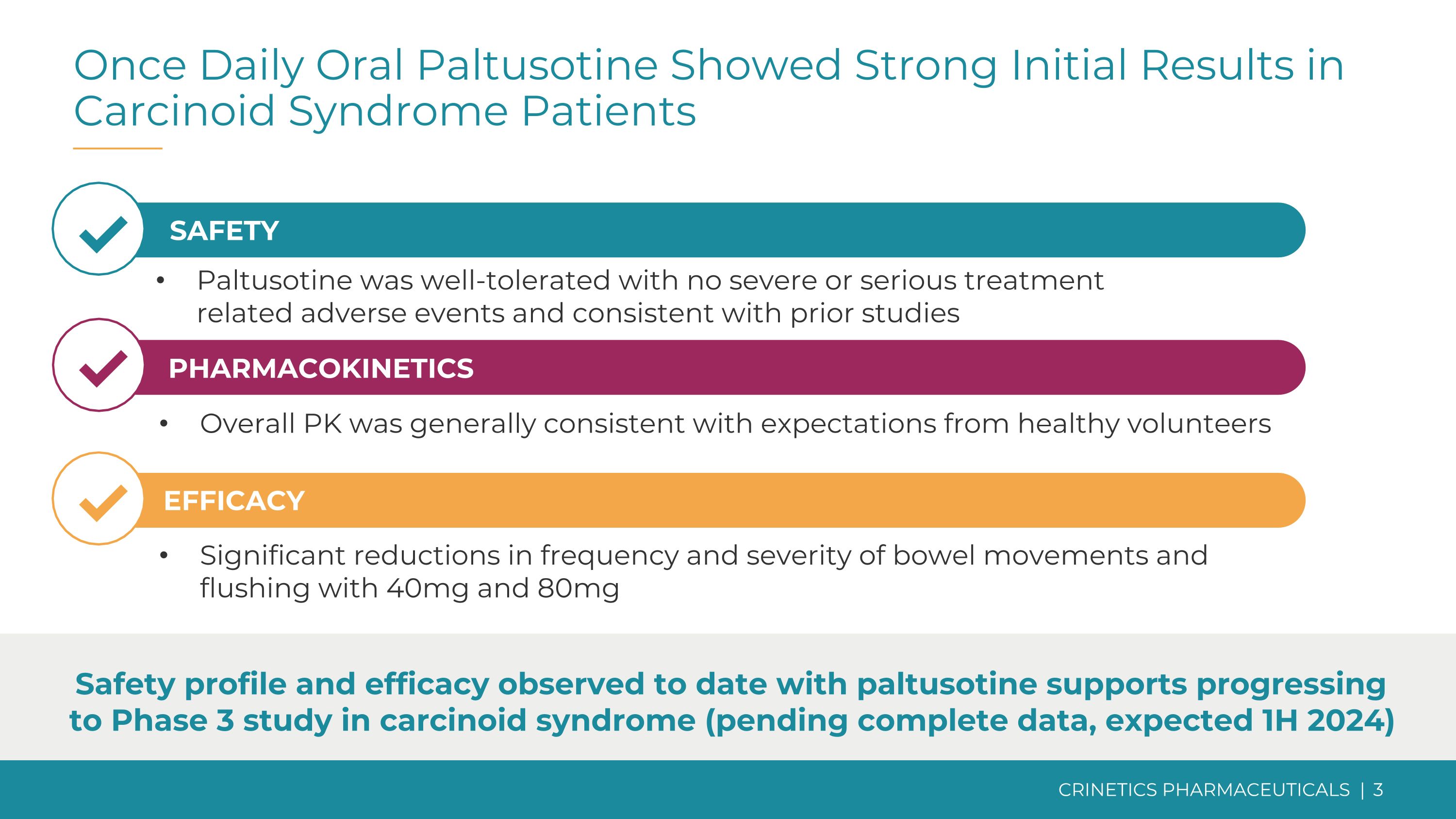
Once Daily Oral Paltusotine Showed Strong Initial Results in Carcinoid Syndrome Patients SAFETY Paltusotine was well-tolerated with no severe or serious treatment related adverse events and consistent with prior studies Overall PK was generally consistent with expectations from healthy volunteers Significant reductions in frequency and severity of bowel movements and flushing with 40mg and 80mg PHARMACOKINETICS EFFICACY Safety profile and efficacy observed to date with paltusotine supports progressing to Phase 3 study in carcinoid syndrome (pending complete data, expected 1H 2024) ✓ ✓ ✓
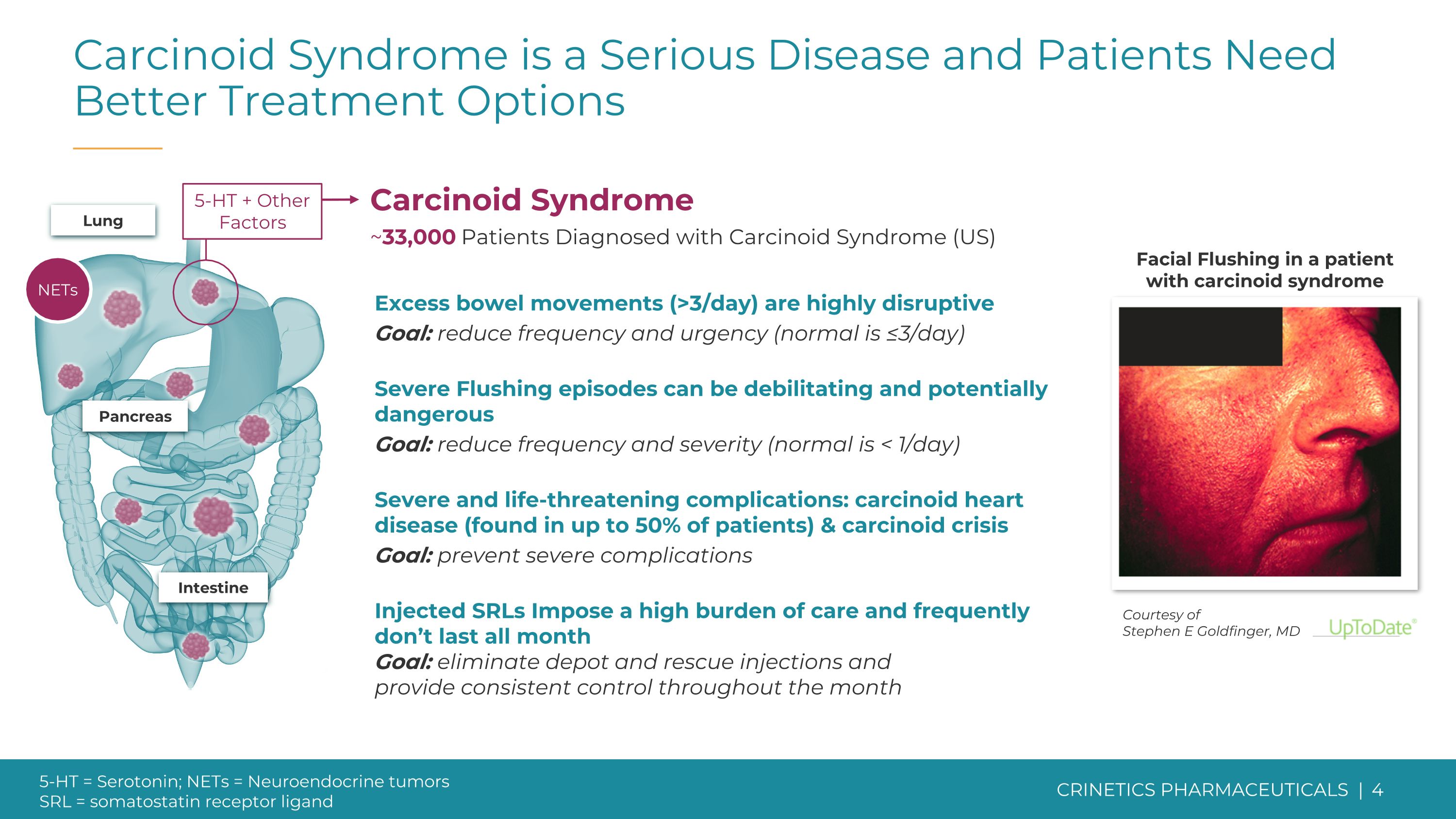
Carcinoid Syndrome is a Serious Disease and Patients Need Better Treatment Options Lung Pancreas NETs Intestine 5-HT + Other Factors Carcinoid Syndrome ~33,000 Patients Diagnosed with Carcinoid Syndrome (US) Facial Flushing in a patient with carcinoid syndrome Courtesy of Stephen E Goldfinger, MD Excess bowel movements (>3/day) are highly disruptive Goal: reduce frequency and urgency (normal is ≤3/day) Severe Flushing episodes can be debilitating and potentially dangerous Goal: reduce frequency and severity (normal is < 1/day) Severe and life-threatening complications: carcinoid heart disease (found in up to 50% of patients) & carcinoid crisis Goal: prevent severe complications Injected SRLs Impose a high burden of care and frequently don’t last all month Goal: eliminate depot and rescue injections and provide consistent control throughout the month 5-HT = Serotonin; NETs = Neuroendocrine tumors SRL = somatostatin receptor ligand
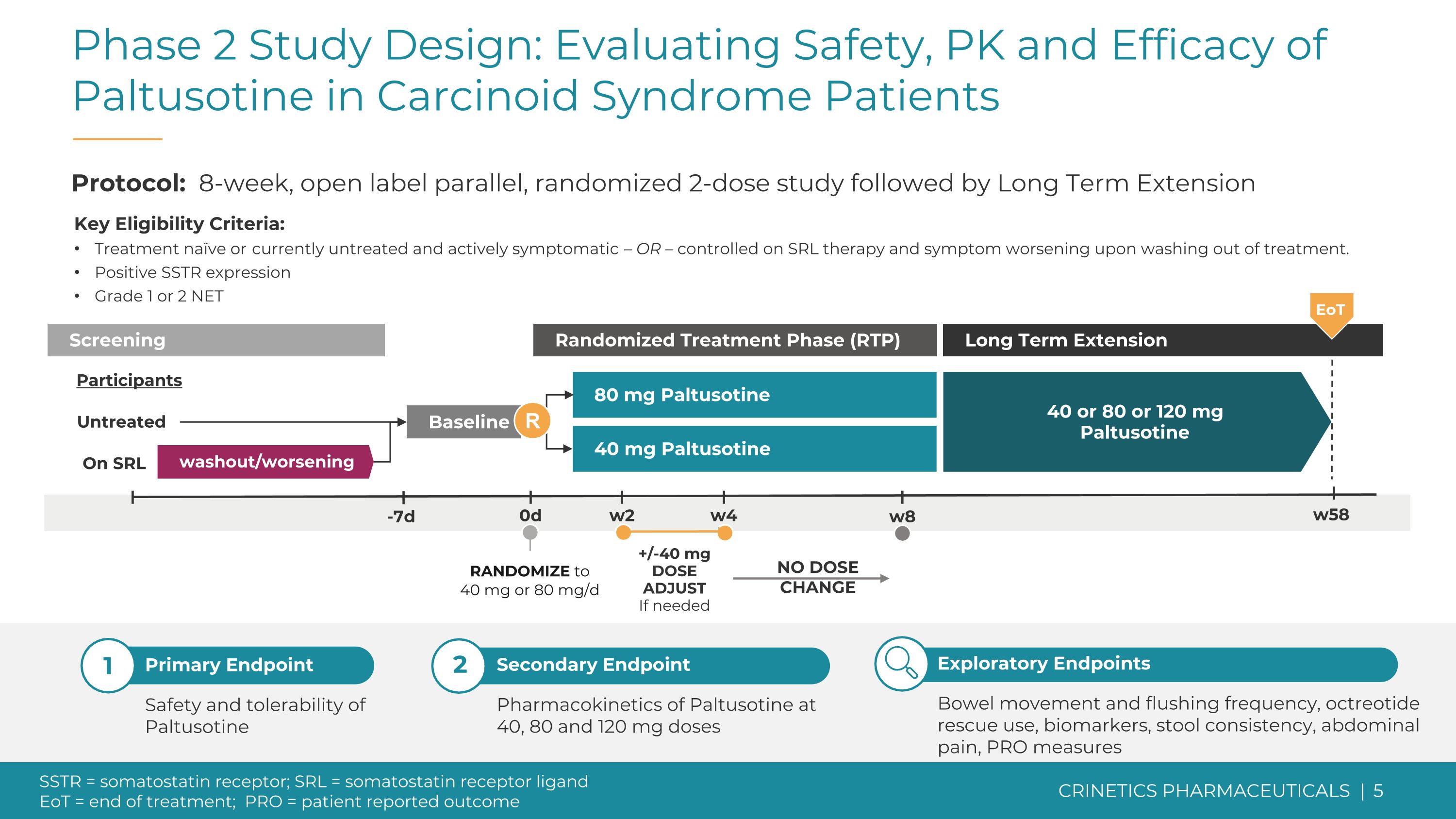
Randomized Treatment Phase (RTP) Screening Baseline Long Term Extension 40 or 80 or 120 mg Paltusotine 80 mg Paltusotine 40 mg Paltusotine R RANDOMIZE to 40 mg or 80 mg/d 0d w2 w4 w8 +/-40 mg DOSE ADJUST If needed NO DOSE CHANGE w58 EoT Key Eligibility Criteria: Treatment naïve or currently untreated and actively symptomatic – OR – controlled on SRL therapy and symptom worsening upon washing out of treatment. Positive SSTR expression Grade 1 or 2 NET Phase 2 Study Design: Evaluating Safety, PK and Efficacy of Paltusotine in Carcinoid Syndrome Patients Protocol: 8-week, open label parallel, randomized 2-dose study followed by Long Term Extension Primary Endpoint Safety and tolerability of Paltusotine Secondary Endpoint Pharmacokinetics of Paltusotine at 40, 80 and 120 mg doses Exploratory Endpoints Bowel movement and flushing frequency, octreotide rescue use, biomarkers, stool consistency, abdominal pain, PRO measures 1 2 SSTR = somatostatin receptor; SRL = somatostatin receptor ligand EoT = end of treatment; PRO = patient reported outcome -7d washout/worsening On SRL Untreated Participants

Disposition and Dosing for the Initial Data Cut (N=27) Safety analysis as of November 27, 2023 initial data cutoff Efficacy analysis based on a minimum of 2 weeks of data available as of the November 27, 2023 data cutoff RTP = Randomized treatment phase (8 weeks); LTE = Long Term Extension Discontinuations N=1 Initial data cut1 N=27 Completed RTP (8 weeks) N=15 Entered LTE Phase N=13 Ongoing in RTP N=7 2+ weeks data available for initial efficacy analysis2 N=23 40mg 80mg Total Naïve/ Untreated 5 4 9 Switching 8 10 18 Total 13 14 27 Dose at Randomization (N=27 initial data cut) <2 Weeks of Treatment N=4 11/15 patients were not dose adjusted
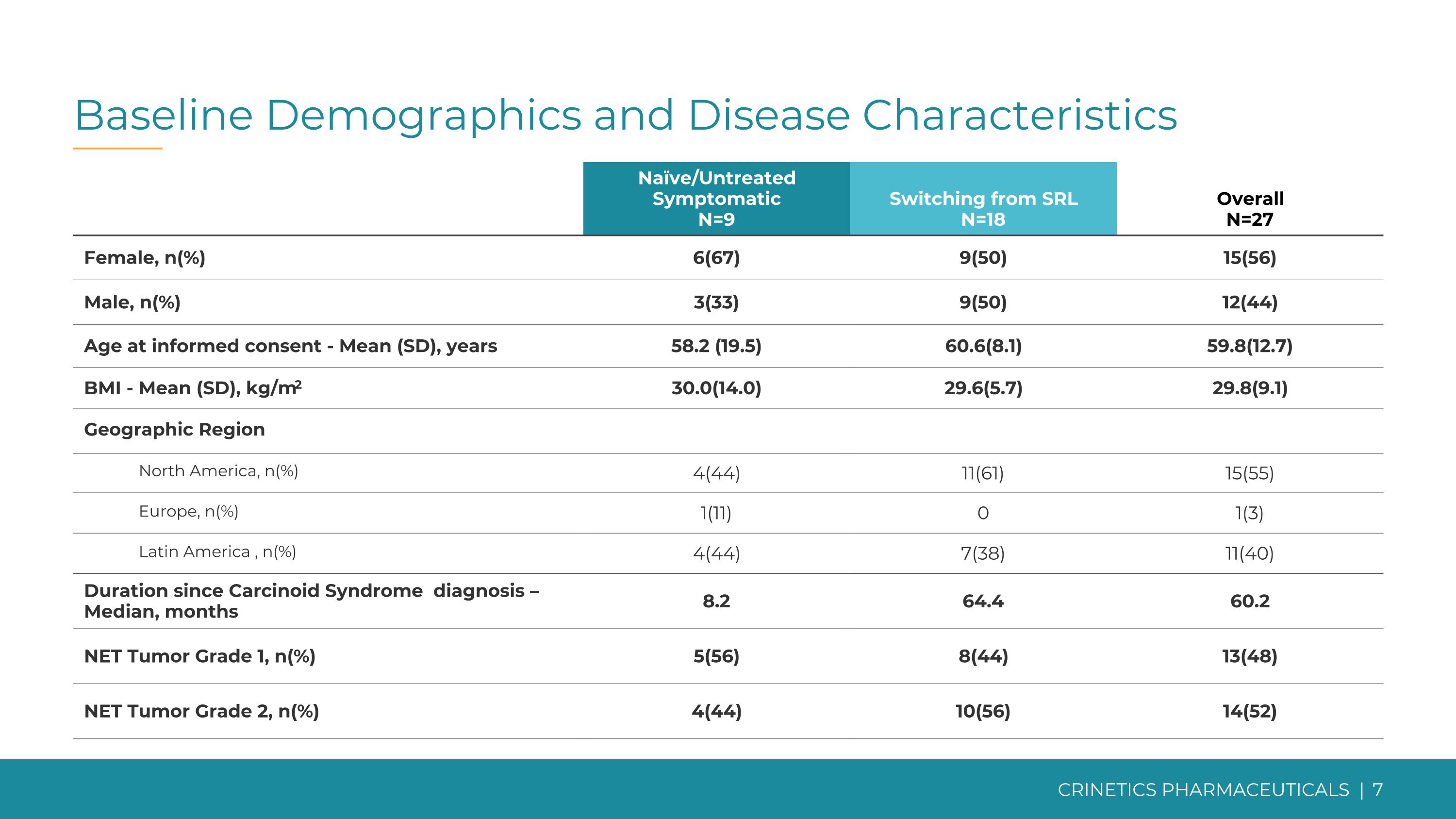
Baseline Demographics and Disease Characteristics Naïve/Untreated Symptomatic N=9 Switching from SRL N=18 Overall N=27 Female, n(%) 6(67) 9(50) 15(56) Male, n(%) 3(33) 9(50) 12(44) Age at informed consent - Mean (SD), years 58.2 (19.5) 60.6(8.1) 59.8(12.7) BMI - Mean (SD), kg/m2 30.0(14.0) 29.6(5.7) 29.8(9.1) Geographic Region North America, n(%) 4(44) 11(61) 15(55) Europe, n(%) 1(11) 0 1(3) Latin America , n(%) 4(44) 7(38) 11(40) Duration since Carcinoid Syndrome diagnosis – Median, months 8.2 64.4 60.2 NET Tumor Grade 1, n(%) 5(56) 8(44) 13(48) NET Tumor Grade 2, n(%) 4(44) 10(56) 14(52)
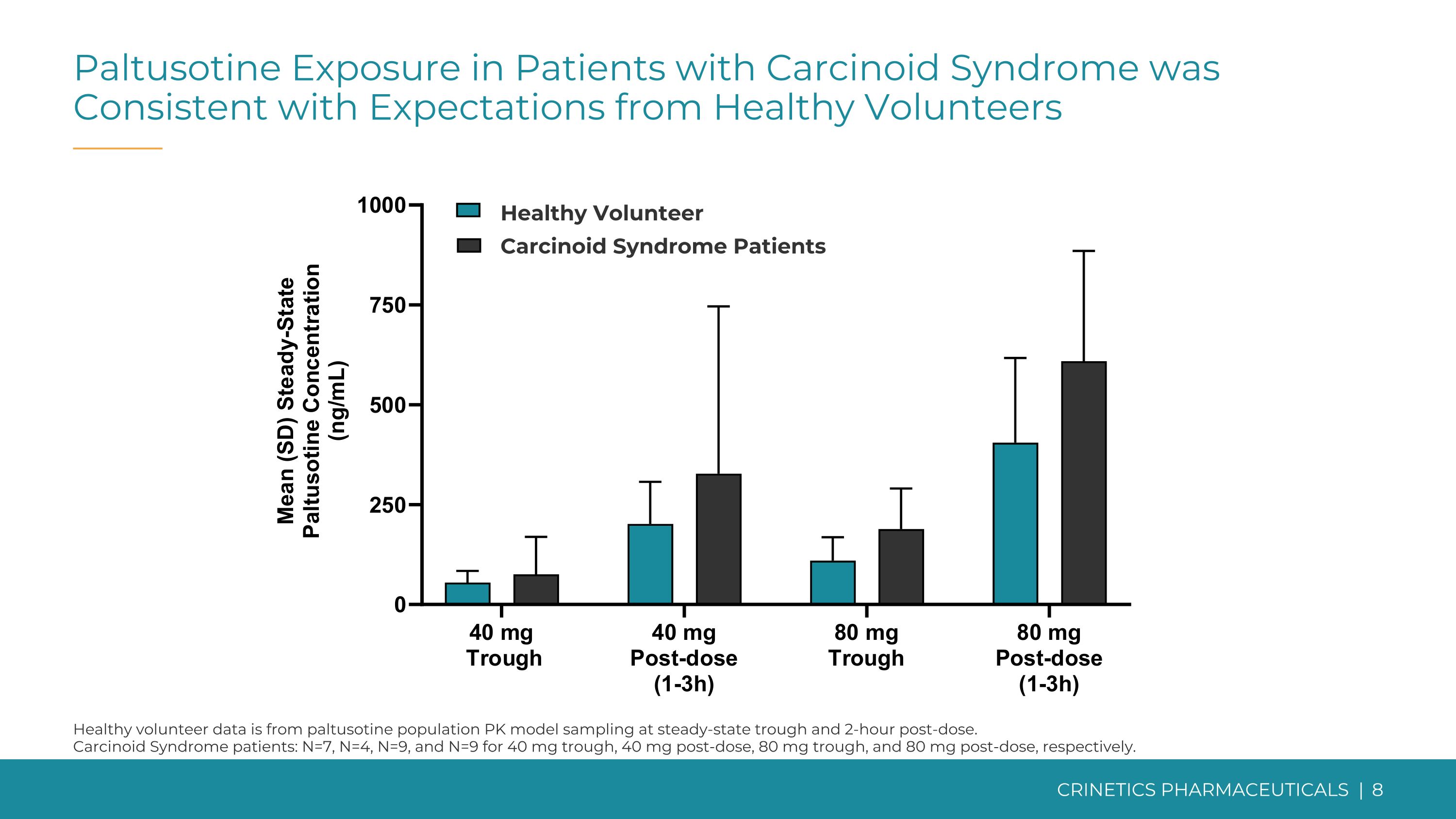
Paltusotine Exposure in Patients with Carcinoid Syndrome was Consistent with Expectations from Healthy Volunteers Healthy volunteer data is from paltusotine population PK model sampling at steady-state trough and 2-hour post-dose. Carcinoid Syndrome patients: N=7, N=4, N=9, and N=9 for 40 mg trough, 40 mg post-dose, 80 mg trough, and 80 mg post-dose, respectively. Healthy Volunteer Carcinoid Syndrome Patients
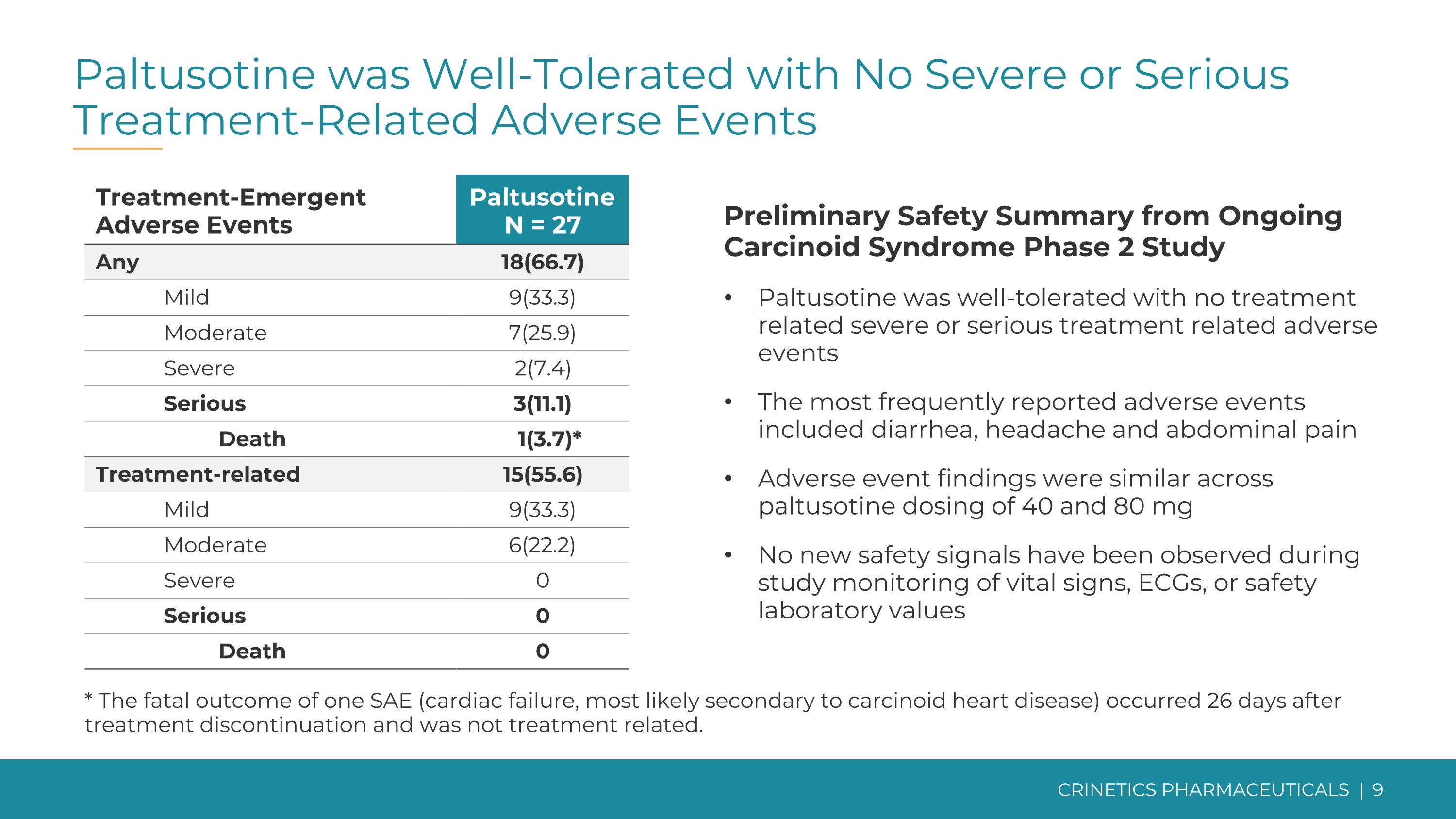
Paltusotine was Well-Tolerated with No Severe or Serious Treatment-Related Adverse Events * The fatal outcome of one SAE (cardiac failure, most likely secondary to carcinoid heart disease) occurred 26 days after treatment discontinuation and was not treatment related. Treatment-Emergent Adverse Events Paltusotine N = 27 Any 18(66.7) Mild 9(33.3) Moderate 7(25.9) Severe 2(7.4) Serious 3(11.1) Death 1(3.7)* Treatment-related 15(55.6) Mild 9(33.3) Moderate 6(22.2) Severe 0 Serious 0 Death 0 Preliminary Safety Summary from Ongoing Carcinoid Syndrome Phase 2 Study Paltusotine was well-tolerated with no treatment related severe or serious treatment related adverse events The most frequently reported adverse events included diarrhea, headache and abdominal pain Adverse event findings were similar across paltusotine dosing of 40 and 80 mg No new safety signals have been observed during study monitoring of vital signs, ECGs, or safety laboratory values
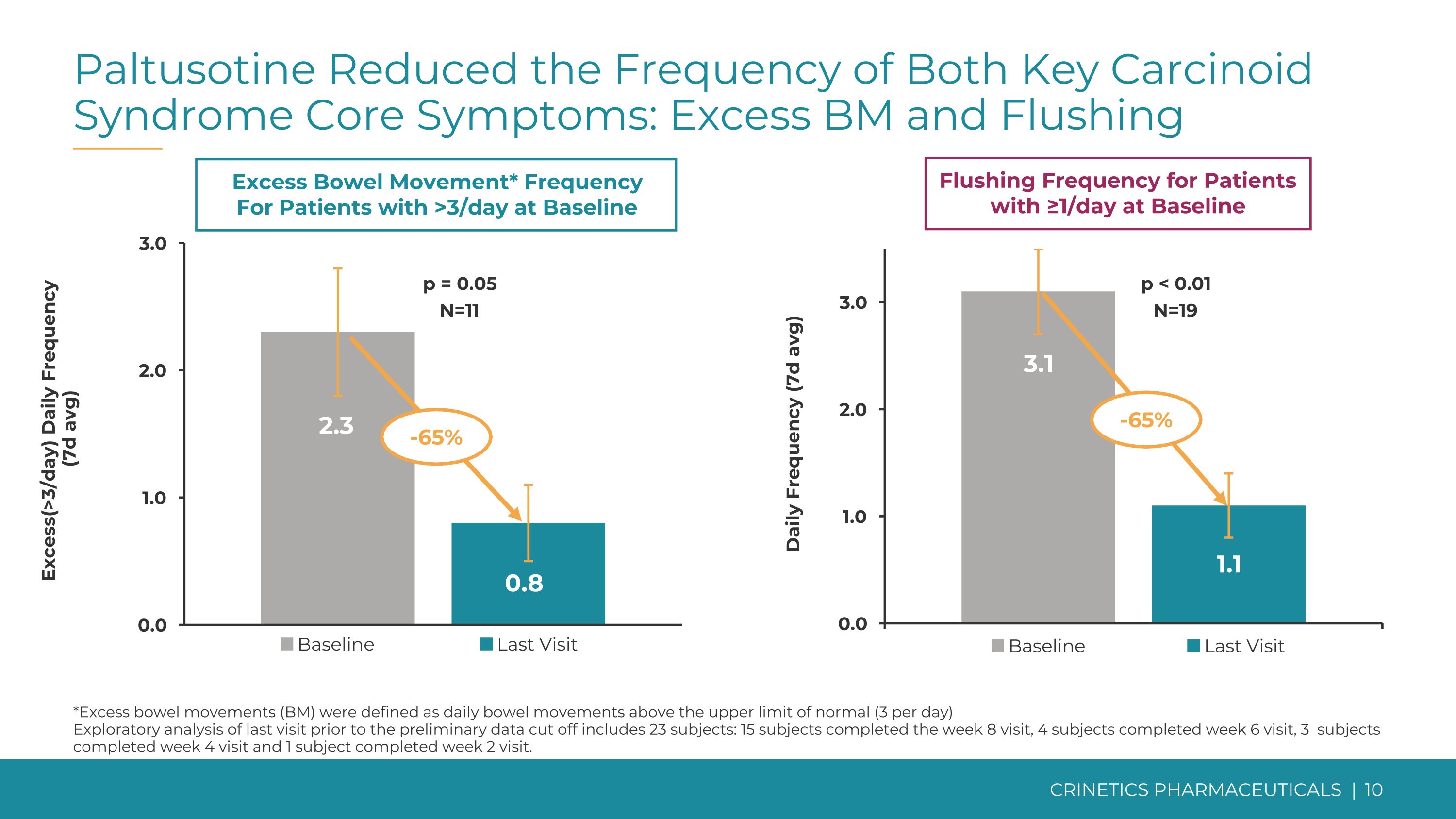
Paltusotine Reduced the Frequency of Both Key Carcinoid Syndrome Core Symptoms: Excess BM and Flushing Excess(>3/day) Daily Frequency (7d avg) Flushing Frequency for Patients with ≥1/day at Baseline Excess Bowel Movement* Frequency For Patients with >3/day at Baseline Daily Frequency (7d avg) p = 0.05 N=11 p < 0.01 N=19 -65% -65% *Excess bowel movements (BM) were defined as daily bowel movements above the upper limit of normal (3 per day) Exploratory analysis of last visit prior to the preliminary data cut off includes 23 subjects: 15 subjects completed the week 8 visit, 4 subjects completed week 6 visit, 3 subjects completed week 4 visit and 1 subject completed week 2 visit.
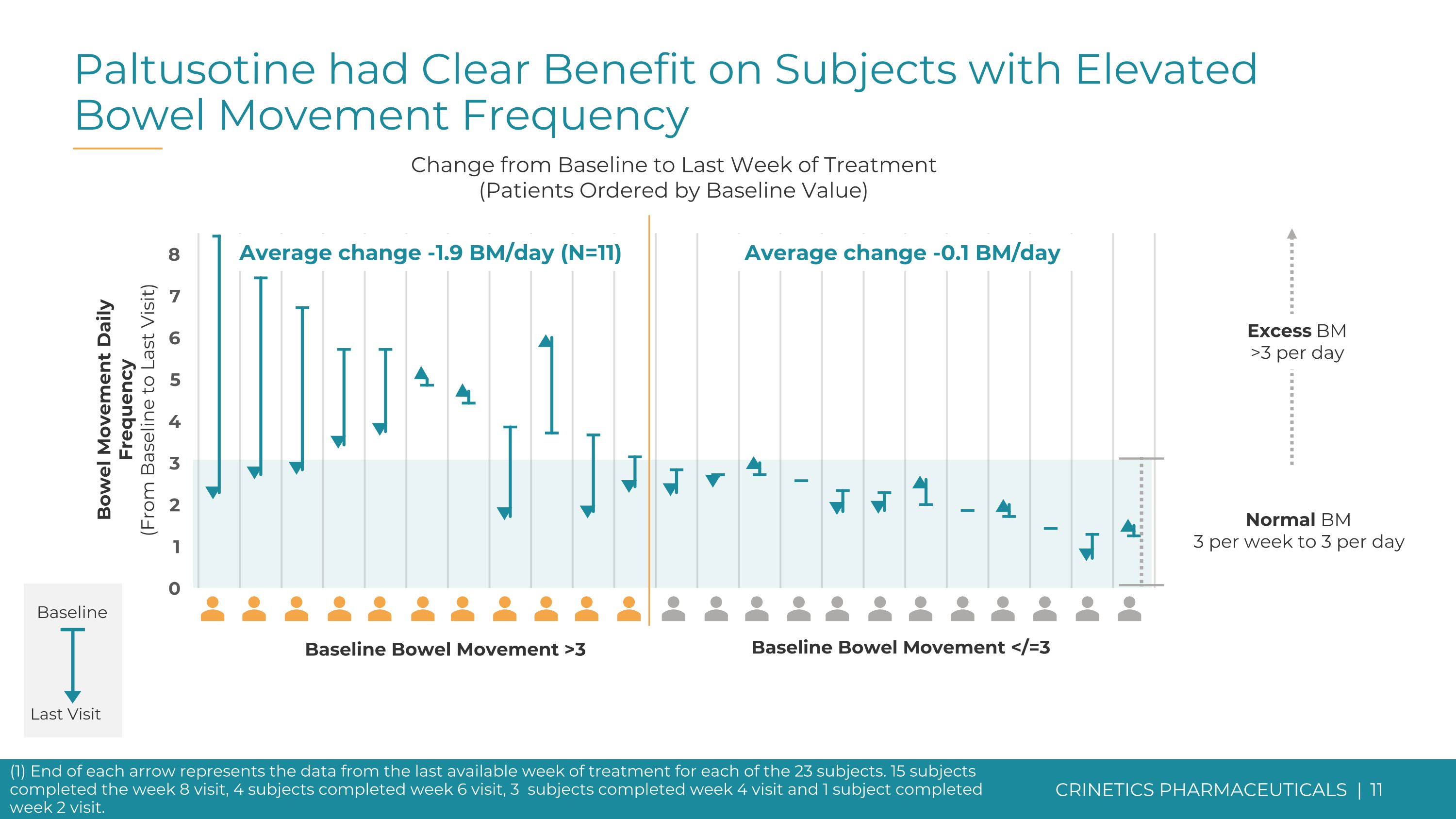
Paltusotine had Clear Benefit on Subjects with Elevated Bowel Movement Frequency Change from Baseline to Last Week of Treatment (Patients Ordered by Baseline Value) Bowel Movement Daily Frequency (From Baseline to Last Visit) Baseline Bowel Movement >3 Baseline Bowel Movement </=3 Normal BM 3 per week to 3 per day Last Visit Baseline (1) End of each arrow represents the data from the last available week of treatment for each of the 23 subjects. 15 subjects completed the week 8 visit, 4 subjects completed week 6 visit, 3 subjects completed week 4 visit and 1 subject completed week 2 visit. Excess BM >3 per day Average change -1.9 BM/day (N=11) Average change -0.1 BM/day
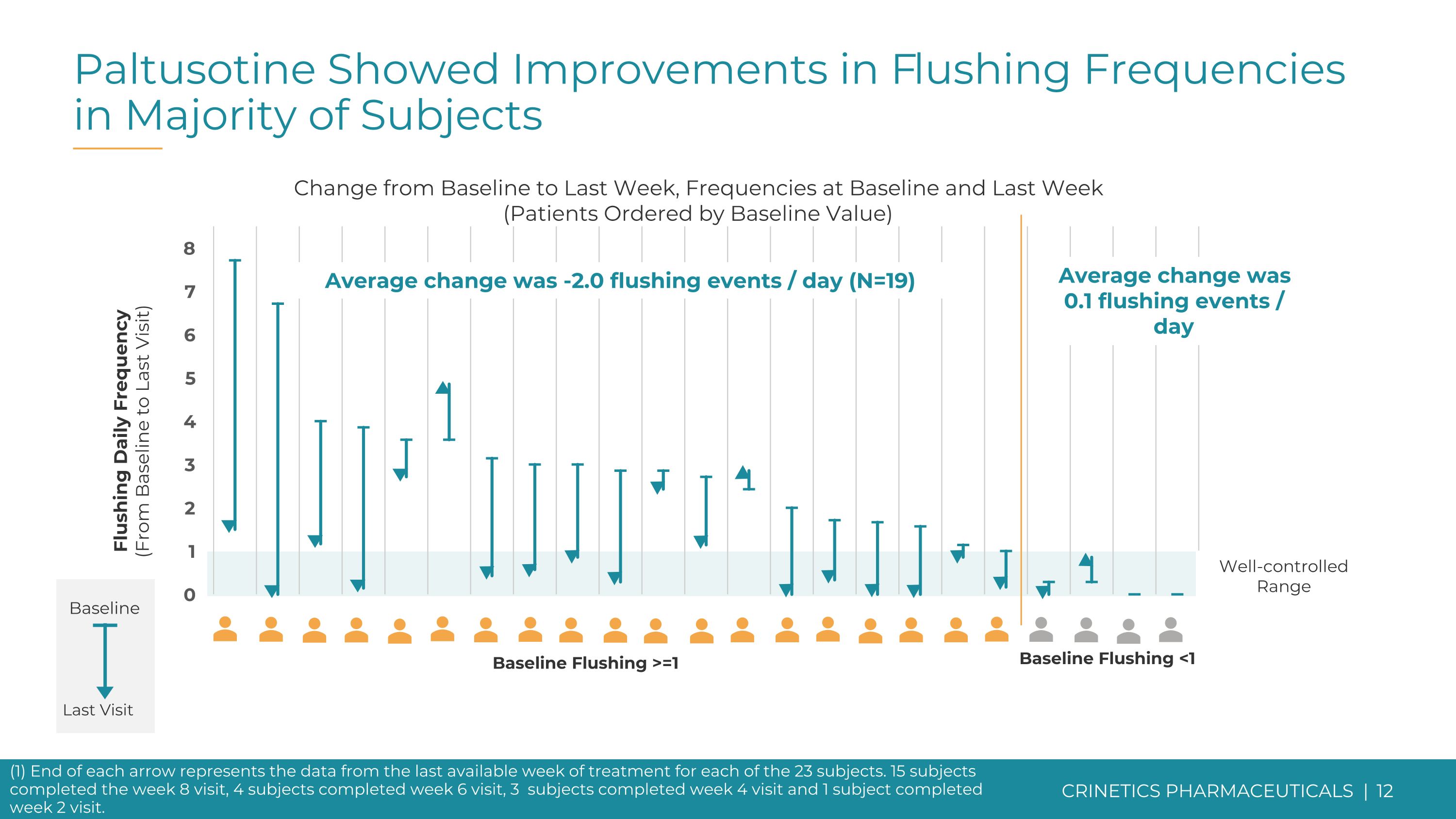
Paltusotine Showed Improvements in Flushing Frequencies in Majority of Subjects Change from Baseline to Last Week, Frequencies at Baseline and Last Week (Patients Ordered by Baseline Value) Flushing Daily Frequency (From Baseline to Last Visit) Baseline Flushing <1 Baseline Flushing >=1 Well-controlled Range Last Visit Baseline (1) End of each arrow represents the data from the last available week of treatment for each of the 23 subjects. 15 subjects completed the week 8 visit, 4 subjects completed week 6 visit, 3 subjects completed week 4 visit and 1 subject completed week 2 visit. Average change was -2.0 flushing events / day (N=19) Average change was 0.1 flushing events / day
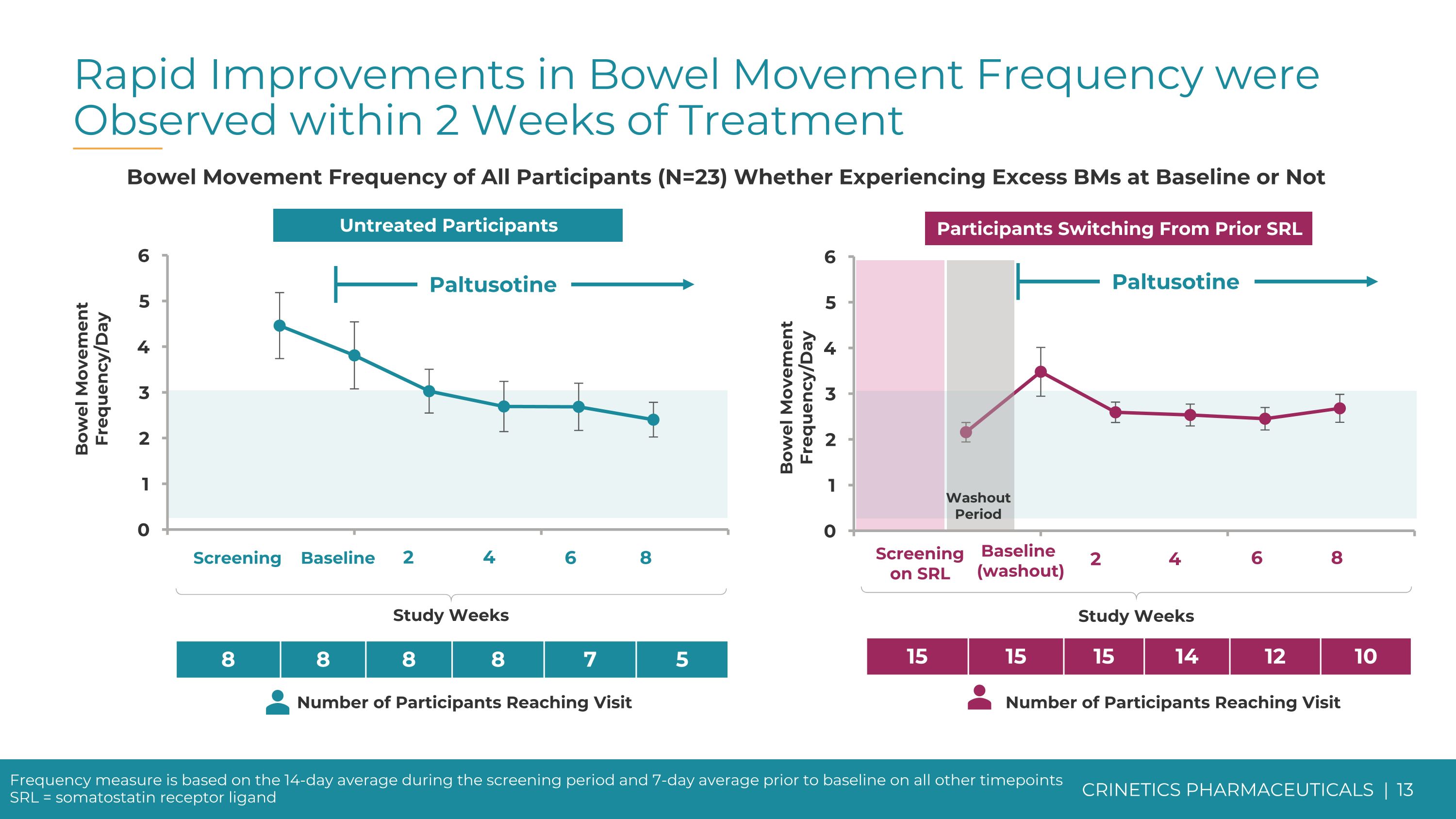
Rapid Improvements in Bowel Movement Frequency were Observed within 2 Weeks of Treatment Bowel Movement Frequency of All Participants (N=23) Whether Experiencing Excess BMs at Baseline or Not 6 8 Screening Baseline 4 2 Study Weeks Bowel Movement Frequency/Day Bowel Movement Frequency/Day 6 8 Baseline (washout) 4 2 Study Weeks 8 8 8 8 7 5 15 15 15 14 12 10 Number of Participants Reaching Visit Untreated Participants Frequency measure is based on the 14-day average during the screening period and 7-day average prior to baseline on all other timepoints SRL = somatostatin receptor ligand Washout Period Number of Participants Reaching Visit Participants Switching From Prior SRL Paltusotine Paltusotine Screening on SRL
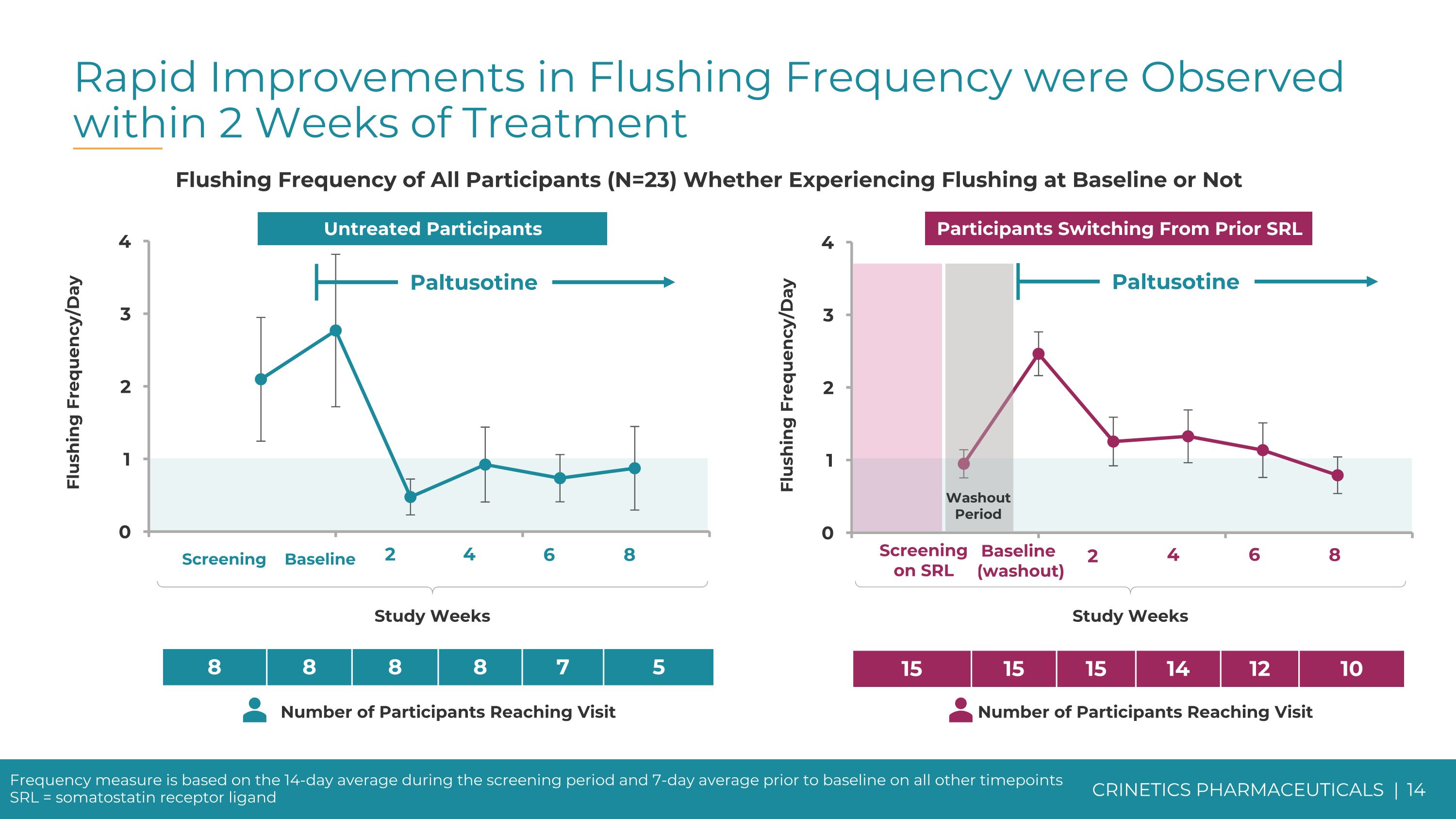
Flushing Frequency of All Participants (N=23) Whether Experiencing Flushing at Baseline or Not Study Weeks 6 8 4 2 Flushing Frequency/Day Participants Switching From Prior SRL 6 8 Screening Baseline 4 2 Study Weeks Untreated Participants Flushing Frequency/Day 8 8 8 8 7 5 15 15 15 14 12 10 Rapid Improvements in Flushing Frequency were Observed within 2 Weeks of Treatment Washout Period Number of Participants Reaching Visit Number of Participants Reaching Visit Paltusotine Paltusotine Baseline (washout) Screening on SRL Frequency measure is based on the 14-day average during the screening period and 7-day average prior to baseline on all other timepoints SRL = somatostatin receptor ligand
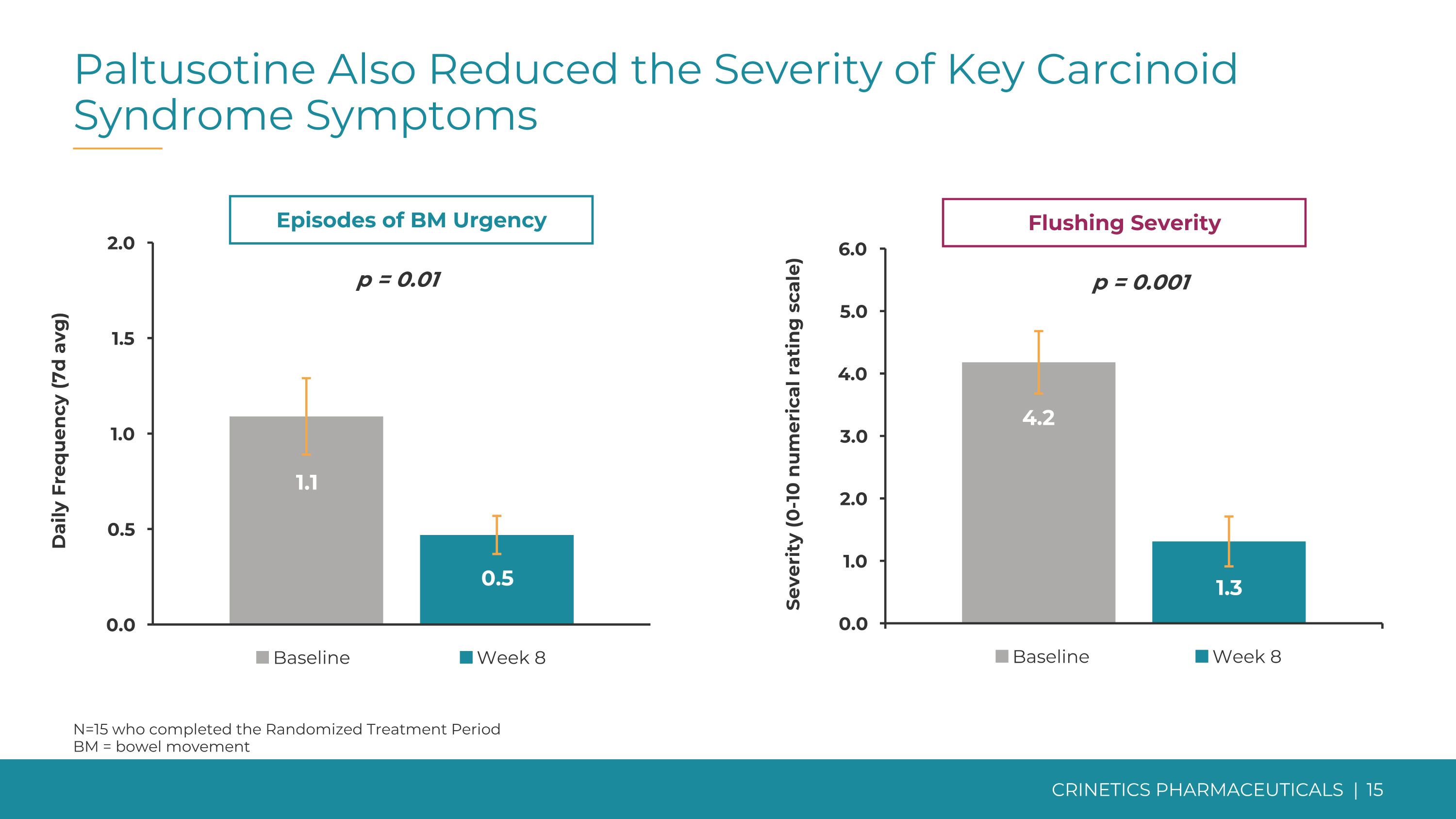
Paltusotine Also Reduced the Severity of Key Carcinoid Syndrome Symptoms N=15 who completed the Randomized Treatment Period BM = bowel movement Daily Frequency (7d avg) Flushing Severity Episodes of BM Urgency N = 23 N = 23 N = 23 N = 23 Severity (0-10 numerical rating scale) p = 0.01 p = 0.001

Example Study Participant #1: Elimination of Flushing and Normalization of BMs Paltusotine 80 mg/day No Prior Therapy Normal BM 3/w to 3d Excess BM >3/d BM = bowel movement
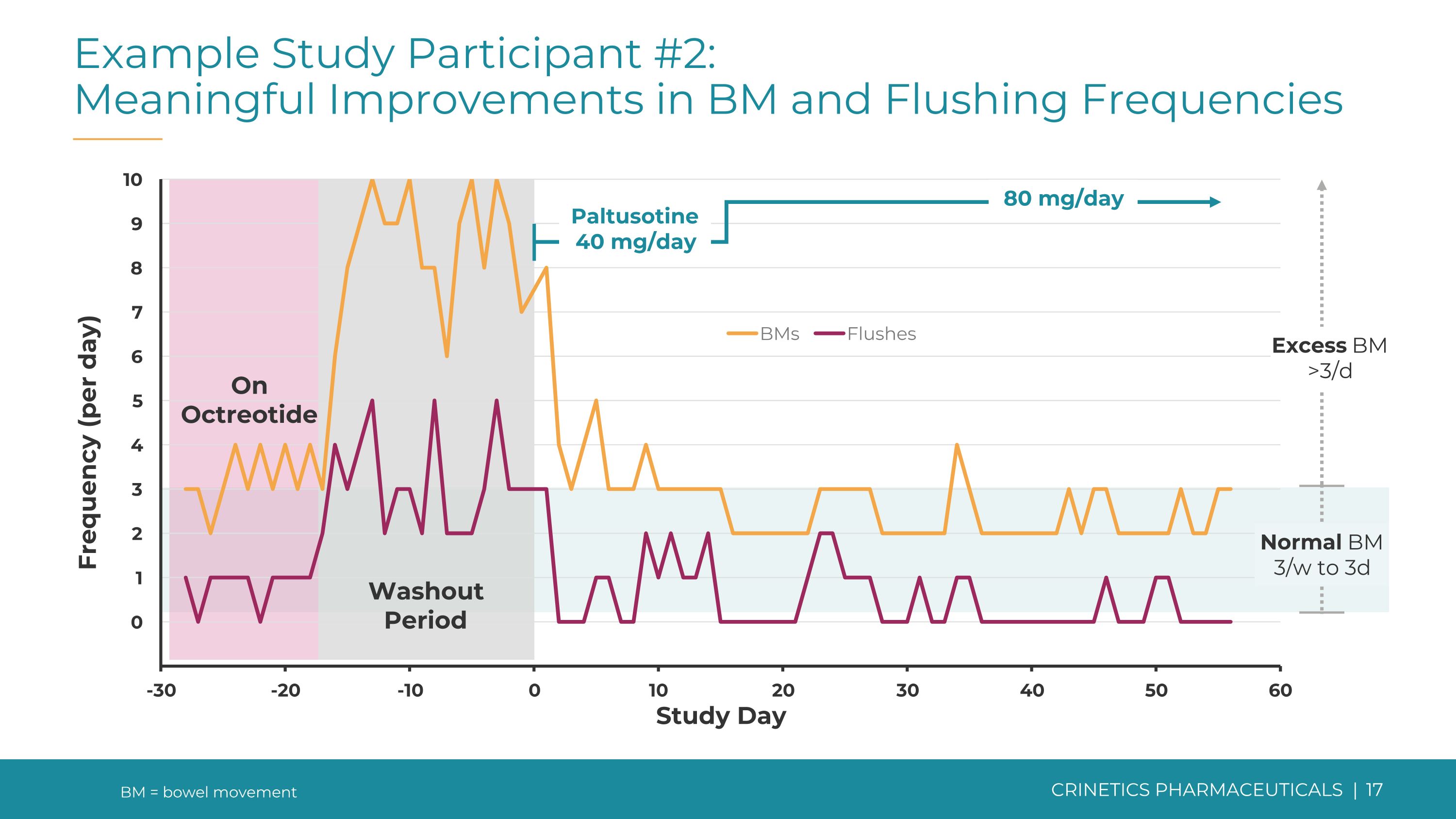
Paltusotine 40 mg/day 80 mg/day Example Study Participant #2: Meaningful Improvements in BM and Flushing Frequencies Washout Period On Octreotide Normal BM 3/w to 3d Excess BM >3/d BM = bowel movement
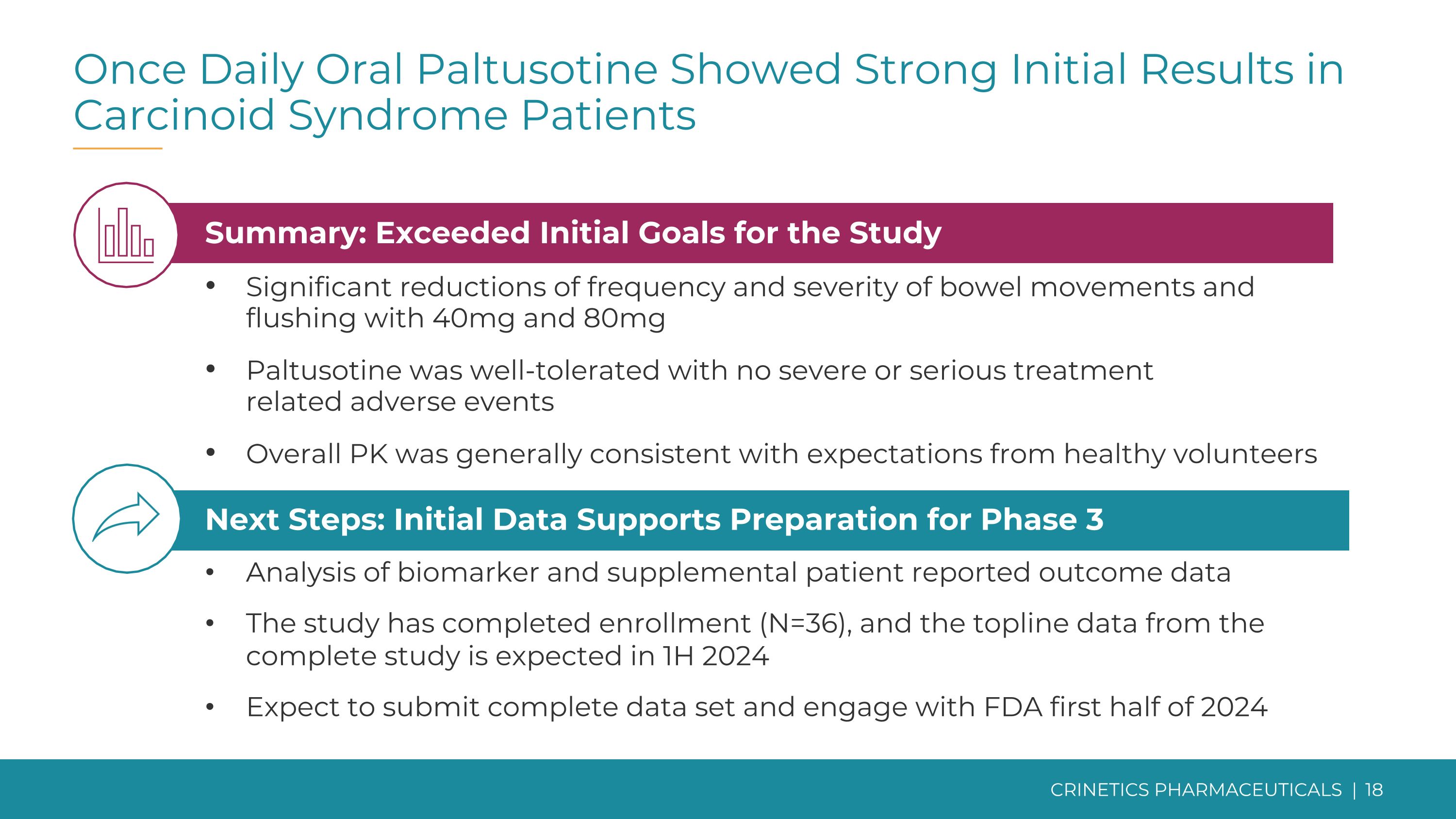
Next Steps: Initial Data Supports Preparation for Phase 3 Analysis of biomarker and supplemental patient reported outcome data The study has completed enrollment (N=36), and the topline data from the complete study is expected in 1H 2024 Expect to submit complete data set and engage with FDA first half of 2024 Once Daily Oral Paltusotine Showed Strong Initial Results in Carcinoid Syndrome Patients Summary: Exceeded Initial Goals for the Study Significant reductions of frequency and severity of bowel movements and flushing with 40mg and 80mg Paltusotine was well-tolerated with no severe or serious treatment related adverse events Overall PK was generally consistent with expectations from healthy volunteers
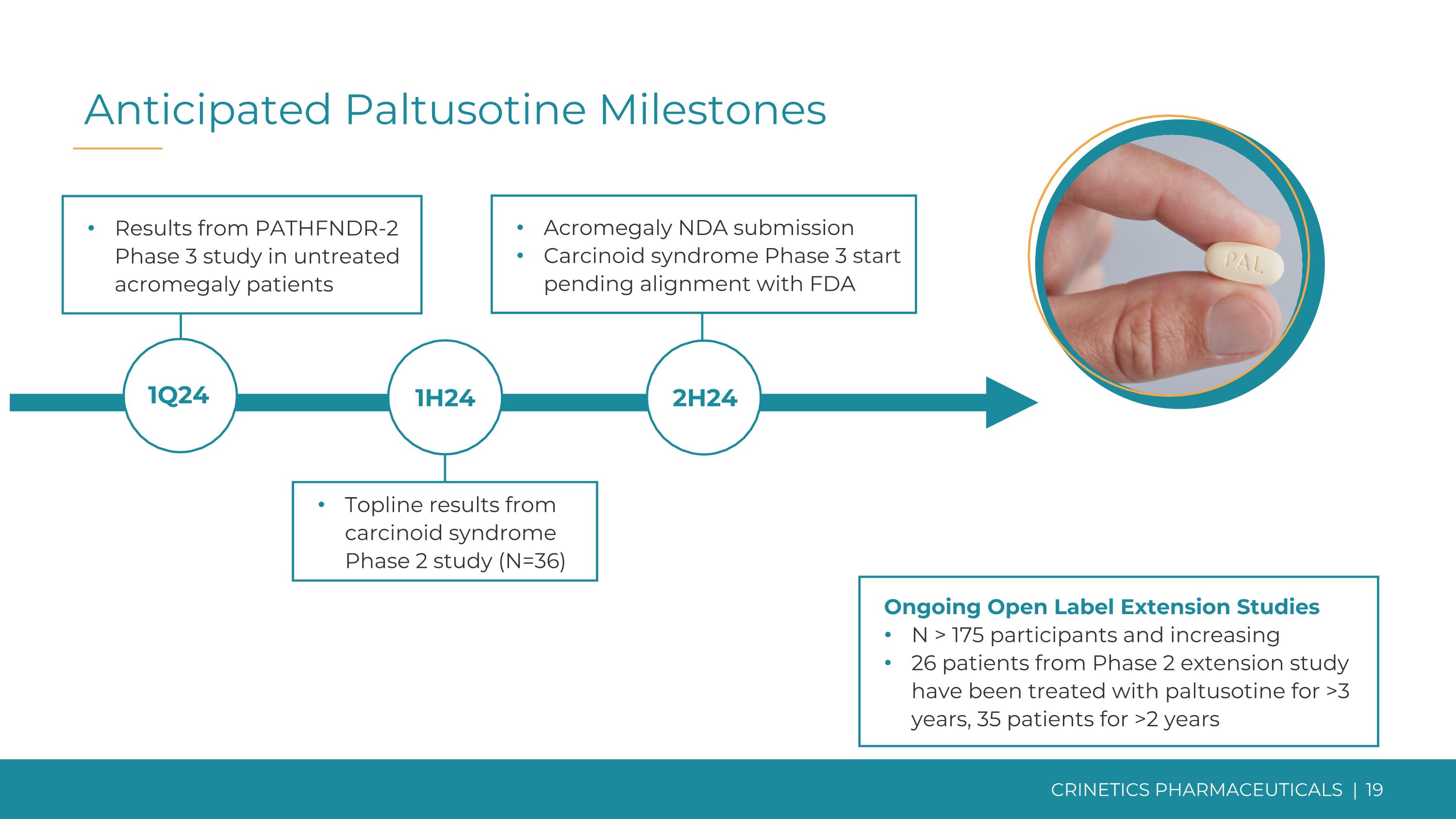
Anticipated Paltusotine Milestones 1Q24 1H24 2H24 Results from PATHFNDR-2 Phase 3 study in untreated acromegaly patients Topline results from carcinoid syndrome Phase 2 study (N=36) Acromegaly NDA submission Carcinoid syndrome Phase 3 start pending alignment with FDA Ongoing Open Label Extension Studies N > 175 participants and increasing 26 patients from Phase 2 extension study have been treated with paltusotine for >3 years, 35 patients for >2 years

Q&A Scott Struthers, Ph.D. Founder and Chief Executive Officer Dana Pizzuti, M.D. Chief Medical & Development Officer Alan Krasner, M.D. Chief Endocrinologist